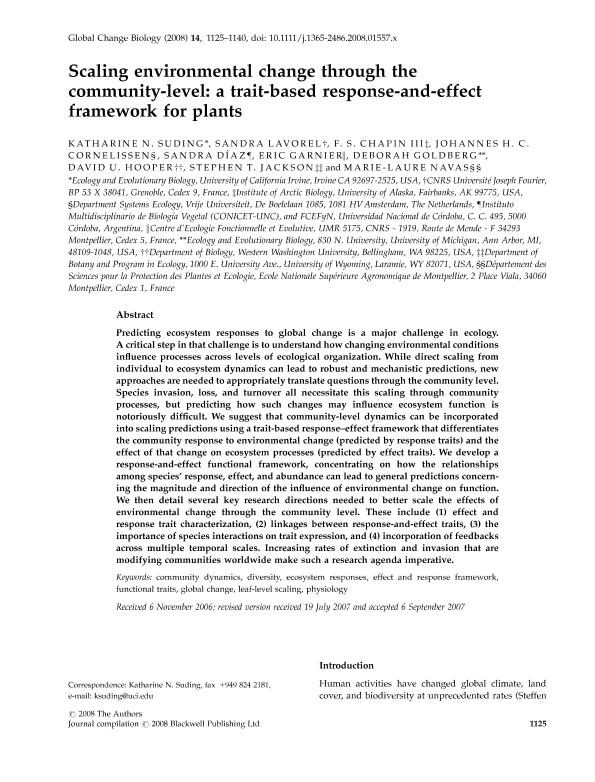Mostrar el registro sencillo del ítem
dc.contributor.author
Suding, Katharine N.
dc.contributor.author
Lavorel, Sandra

dc.contributor.author
Chapin, F. S.
dc.contributor.author
Cornelissen, Johannes H.
dc.contributor.author
Diaz, Sandra Myrna

dc.contributor.author
Garnier, Erik
dc.contributor.author
Goldberg, Deborah
dc.contributor.author
Hooper, David U.
dc.contributor.author
Jackson, Stephan T.
dc.contributor.author
Navas, Marie Laure
dc.date.available
2017-08-16T18:48:10Z
dc.date.issued
2008-12
dc.identifier.citation
Suding, Katharine N.; Lavorel, Sandra; Chapin, F. S.; Cornelissen, Johannes H.; Diaz, Sandra Myrna; et al.; Scaling environmental change through the community-level: a trait-based response-and-effect framework for plants; Wiley Blackwell Publishing, Inc; Global Change Biology; 14; 5; 12-2008; 1125-1140
dc.identifier.issn
1354-1013
dc.identifier.uri
http://hdl.handle.net/11336/22530
dc.description.abstract
Predicting ecosystem responses to global change is a major challenge in ecology. A critical step in that challenge is to understand how changing environmental conditions influence processes across levels of ecological organization. While direct scaling from individual to ecosystem dynamics can lead to robust and mechanistic predictions, new approaches are needed to appropriately translate questions through the community level. Species invasion, loss, and turnover all necessitate this scaling through community processes, but predicting how such changes may influence ecosystem function is notoriously difficult. We suggest that community-level dynamics can be incorporated into scaling predictions using a trait-based response?effect framework that differentiates the community response to environmental change (predicted by response traits) and the effect of that change on ecosystem processes (predicted by effect traits). We develop a response-and-effect functional framework, concentrating on how the relationships among species? response, effect, and abundance can lead to general predictions concerning the magnitude and direction of the influence of environmental change on function. We then detail several key research directions needed to better scale the effects of environmental change through the community level. These include (1) effect and response trait characterization, (2) linkages between response-and-effect traits, (3) the importance of species interactions on trait expression, and (4) incorporation of feedbacks across multiple temporal scales. Increasing rates of extinction and invasion that are modifying communities worldwide make such a research agenda imperative.
dc.format
application/pdf
dc.language.iso
eng
dc.publisher
Wiley Blackwell Publishing, Inc

dc.rights
info:eu-repo/semantics/openAccess
dc.rights.uri
https://creativecommons.org/licenses/by-nc-sa/2.5/ar/
dc.subject
Community Dynamics
dc.subject
Plant Functional Traits
dc.subject
Effects And Response Framework
dc.subject
Global Enviromental Change
dc.subject
Ecosystems
dc.subject.classification
Ecología

dc.subject.classification
Ciencias Biológicas

dc.subject.classification
CIENCIAS NATURALES Y EXACTAS

dc.title
Scaling environmental change through the community-level: a trait-based response-and-effect framework for plants
dc.type
info:eu-repo/semantics/article
dc.type
info:ar-repo/semantics/artículo
dc.type
info:eu-repo/semantics/publishedVersion
dc.date.updated
2017-07-25T12:38:39Z
dc.identifier.eissn
1365-2486
dc.journal.volume
14
dc.journal.number
5
dc.journal.pagination
1125-1140
dc.journal.pais
Estados Unidos

dc.journal.ciudad
Hoboken
dc.description.fil
Fil: Suding, Katharine N.. University of California Irvine. Ecology and Evolutionary Biology; Estados Unidos
dc.description.fil
Fil: Lavorel, Sandra. Université Joseph Fourier; Francia
dc.description.fil
Fil: Chapin, F. S.. University of Alaska. Institute of Arctic Biology; Estados Unidos
dc.description.fil
Fil: Cornelissen, Johannes H.. Vrije Universiteit. Department Systems Ecology; Países Bajos
dc.description.fil
Fil: Diaz, Sandra Myrna. Consejo Nacional de Investigaciones Científicas y Técnicas. Centro Científico Tecnológico Conicet - Córdoba. Instituto Multidisciplinario de Biología Vegetal. Universidad Nacional de Córdoba. Facultad de Ciencias Exactas Físicas y Naturales. Instituto Multidisciplinario de Biología Vegetal; Argentina
dc.description.fil
Fil: Garnier, Erik. Centre d’Ecologie Fonctionnelle et Evolutive; Francia
dc.description.fil
Fil: Goldberg, Deborah. University of Michigan. Ecology and Evolutionary Biology; Estados Unidos
dc.description.fil
Fil: Hooper, David U.. Western Washington University. Department of Biology; Estados Unidos
dc.description.fil
Fil: Jackson, Stephan T.. University of Wyoming. Department of
Botany and Program in Ecology; Estados Unidos
dc.description.fil
Fil: Navas, Marie Laure. Ecole Nationale Superieure Agronomique de Montpellier. Departement des Sciences pour la Protection des Plantes et Ecologie; Francia
dc.journal.title
Global Change Biology

dc.relation.alternativeid
info:eu-repo/semantics/altIdentifier/url/http://onlinelibrary.wiley.com/doi/10.1111/j.1365-2486.2008.01557.x/full
dc.relation.alternativeid
info:eu-repo/semantics/altIdentifier/doi/http://dx.doi.org/10.1111/j.1365-2486.2008.01557.x
Archivos asociados
